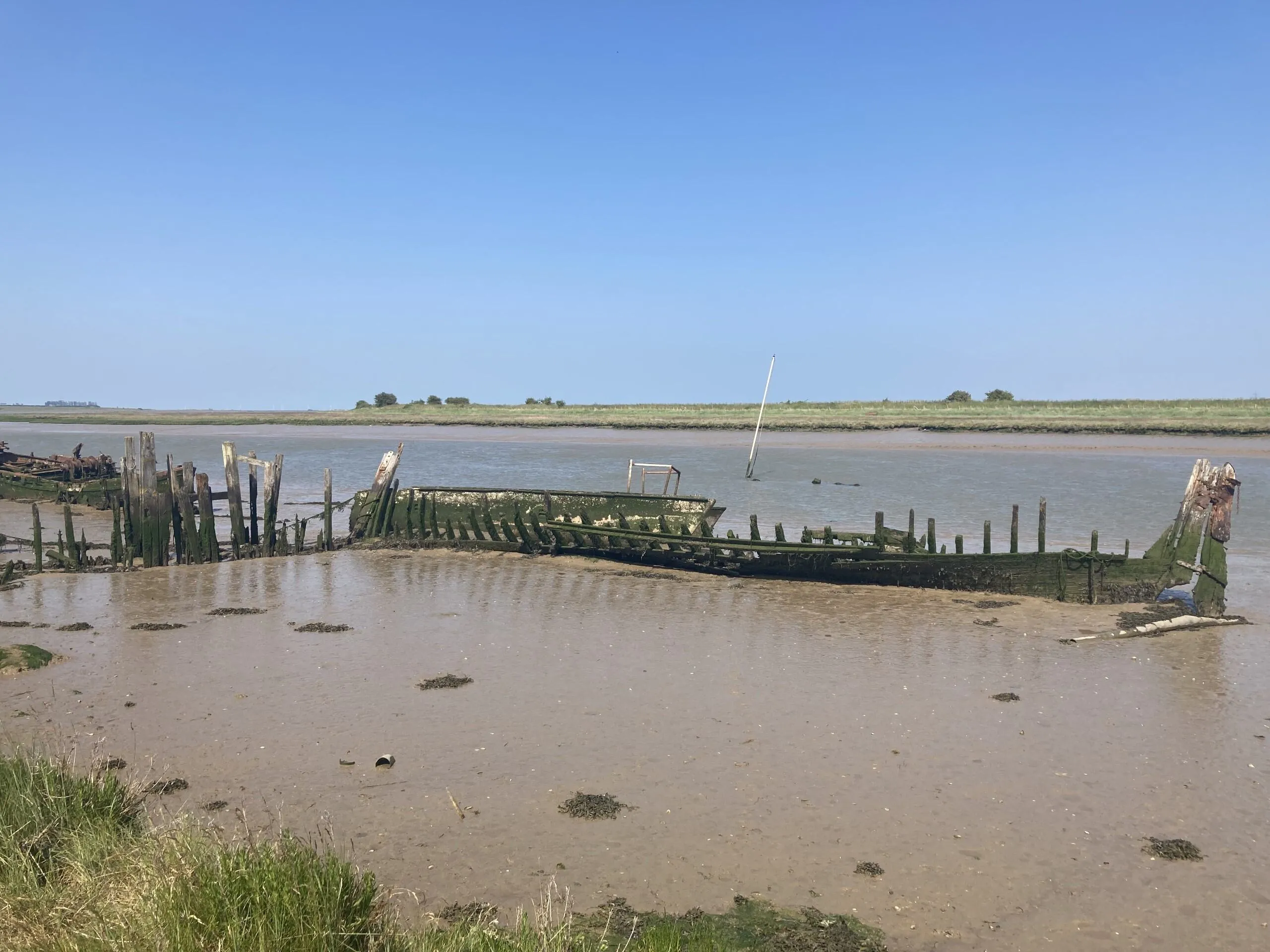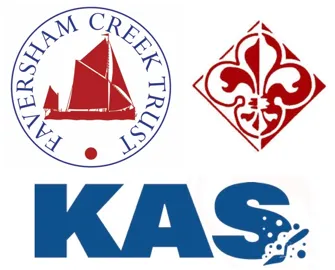
In late May to early June, the Swale Estuary team hosted a series of free community events at venues ranging from a historic pub to an archaeological excavation as part of the sun-drenched Open Faversham Festival.
In partnership with Kent Archaeological Society, the Faversham Creek Trust, the Shipwright’s Arms and the Faversham Society, five Coasts in Mind public drop-in sessions helped celebrate local knowledge by mapping memories, personal photos and postcard collections. The town’s deep coastal connections, which include the maritime prosperity of the medieval Cinque Port (as a limb of Dover) as well as a prosperous relationship with the shoreline marshes and the marine resource of the intertidal creek itself, are not always apparent. But the 2025 Festival saw this heritage brought thrillingly to life, and the Coasts in Mind residency was spent listening to or recording personal stories and pictures relating to the creeks and Swale (many of which had never been seen or heard by the public). Sharing cups of tea and the season’s first Kentish strawberries, locals and visitors were invited to add their thoughts on change and resilience to our interactive ‘ribbon sea’. There was laughter, tears, and a palpable pride in how much the coastal area had endured, preserved and adapted.

Event Setup, MOLA.

Listening to Memories, MOLA.
Event one: KAS Community Excavation, Front Brents Car Park, Faversham
“Digging deeper into memory”
In the quiet of the morning with nothing but the calls of Oyster Catchers punctuating the air, the Coasts in Mind marquee was deployed for the first of three days within the community excavation compound. Open to the public, the site was soon inundated with over a hundred inquisitive visitors and volunteers, all with compelling stories to tell and a keen interest in the Swale coastline. The symphony of trowels scraping away layers of time accompanied our conversations as participants uncovered the foundations of the 19th century terraced housing, originally built for brickfield workers. One of the houses beneath our feet, locals were telling us, “... doubled as a shop serving the shipwrights from James Pollock Sons & Co. shipyard as well as bargemen from the smacks and sailing barges”.
Beneath the compacted demolition layer, sherds of Victorian ceramics, clay pipes, coins and rusted nails painted a picture of daily life before these homes were demolished in the 1960’s. Modest dwellings, relying on communal wells and pumps instead of piped water, which were among the last to go on mains sewage in Faversham, they were always prone to flooding. Their fate may have been sealed by the infamous tidal surges of 1953 and further development on this side of the creek, but the sense of shared memory in their rediscovery was electric. A particularly moving moment came when Jackie, Winnifred Phipps’ granddaughter, stood on the exact spot where her nan’s shop and no. 14 where she was born once stood. She shared the stories of her pictures for the archive, and held one of the uncovered bricks that once comprised their home - connecting past to future in a single gesture.

Circa 1951, Front elevation of Mrs Winifred Phipps shop, Front Brents. Winifred (nan to Jackie) centre, baby Jean left and brother Peter right. Image courtesy of Jackie Reynolds.

1953 Front Brents Coronation Street Party along Faversham Creek (with the Albion pub in background). Image courtesy of Jackie Reynolds.
Event two: KAS Community Excavation, Front Brents Car Park, Faversham
“…ancient highways, a place of ships and shipwrights”
The second day brought more waves of enthusiastic drop-ins from Sheppey to Whitstable, sitting down with archaeologists to stitch their personal histories into a larger map of coastal change. The day offered a reflective lens, with locals bringing old postcards and holiday snapshots for archaeologists to scan into the archive, which stimulated joyful reminiscences for the participants and a lot of laughs all around. Many connected over shared memories of watching huge ocean -going vessels launched sideways down the slips from Pollock’s yard into the narrow creek. One resident remembered “waiting for waves to drench us on the offside bank like waiting at the end of log-flume”, while a woman with a cheeky glint in her eye noted that “We knew to stay clear, but didn’t warn newcomers as it made for good viewing.”
Others spoke of the heartbreak when the yard, which opened in 1916, closed in 1970 after decades of skilled maritime craft and ingenuity that had defined the area. Rightly proud of it’s heritage and maritime livelihoods, boat building traditions and the skills of shipwrights continue in the town at Iron Wharf and in the Boatshed at the Purifier Building (Faversham Creek Trust).

Union Lighterage Co. Steel Motor Vessel ULCO on the “stocks” at J. Pollock, Sons & Co. Ltd. shipyard, Faversham in 1958 – Image courtesy Ann Jemmett and Dawn Emery.

Lauch of the tug “Lord davenport” at J. Pollock, Sons & Co. Ltd. shipyard, Faversham in 1959 – Image courtesy Ann Jemmett and Dawn Emery.
Event Three: Fleur de Lis Museum, Faversham
“A cruel mistress and a landscape of change”
A change of scenery and a bit of shelter from the wind and sun as we were hosted by the fantastic volunteers of the Faversham Society at their free-to-enter museum in the heart of Faversham. With our video about coastal change in the region due to rising sea levels compounded by climate change and Holocene Isostatic adjustment/sinking projected into one of the galleries, visitors were invited to reflect on a natural and historic environment characterised by change. Many drew comparisons with their local area or beaches, while locals recounted the major flooding episodes in 1953 and 1978/79 as a result of tidal surges in the Swale Estuary. Properties damaged and people wading through waist-high water in the streets or using row boats. A map of the Swale Estuary, dotted with pinned memories, grew fuller with each passing hour.
Families and couples exploring the museum were delighted to explore our finds handling collection, retrieved from the foreshore during archaeological walk-over survey conducted by our incredible partners at Timescapes Kent. The finds spanned human activity from the prehistoric, through Roman occupation to the modern period. Children’s faces lit up as they compared their foot size to the leather sole of a 17th century shoe or traced the fish bones of a 120,000-year-old fossil. Some visitors were surprised to learn that the creek itself had been forcibly straightened in the 1840s - a move that many believe worsened flooding, especially around the Crab Island area, which would ultimately affect the Front Brents terraces as we were finding out.

Inputs and memories of community members added to map via post-it notes and markers during one event, MOLA.
Event Four: KAS Community Excavation, Front Brents Car Park, Faversham
“…the salt that binds us”
The final day of the dig drew history lovers, families, and lifelong residents to the creek’s edge, just steps from the Albion Taverna. With trowels in hand and stories in their hearts, they got stuck into cleaning archaeological features together with contributing their perspectives, drawings and feelings to our ‘ribbon sea’ installation. Volunteers and participants responded to prompts about indicators of change and community resilience on marine wildlife shapes, tethering them to our wall of sea-coloured ribbons so that we could engage with what the community felt was most important in terms of coastal change.
Local knowledge brought yet more revelations as residents recalled flooding episodes. An energetic lady recalled waiting on the Albion side of the bridge for the high tide flooding so that she “had good reason to be late for school”. A man reported firsthand how floods like that of 2013 would send water lapping into living rooms. Another woman who lived on Upper Brents told us how they campaigned for further flood defences after the 2013 floods which, eventually led to the installation of the bund (an earthen embankment along Front Brents) in the summer of 2016 by the Environmental Agency.
Q. What does a resilient Coastal community look like to you?”
“A resilient community needs to adapt and change with the times. Faversham has been around for a long time and seen many changes and survived and will continue to do so fro years to come”
Q. Draw or tell us about local beaches, creeks, marshes, or cliffs that make this coast unique. Has this changed?
“The beautiful meanders of Faversham Creek and Conyer creek through the marshes”
“We have the north Kent marshes, then from sea salter to whitstable Shingle beach and from Whitstable to Herne bay Pebble beach”
Q. What elements of this area’s past are meaningful for you? Why is this important now?
“It’s people – the community of the Swale is imbedded in it’s towns (it’s buildings), the waterways as a gateway to the sea”

Images of our ‘ribbon sea’ wall installed and being interacted with by members of the public, MOLA.
Event Five: The Shipwrights Arms, Hollowshore
“Echoes from the estuary.”
Set against the evocative backdrop of the 17th century Shipwrights Arms, the final event yielded stories from locals living on the marshes at the confluence of Oare and Faversham Creeks with the Swale itself. Beneath wooden beams adorned with charts and maritime signal flags, we heard of three generations of boatbuilders at the Hollowshore Boat Yard, still in operation just outside the front door. It’s like we were communing in a nautical temple.
Our maps and artefacts lined the pub’s old tables, and complimentary souvenir coasters featuring iconic scenes from the Swale's maritime past went down well as patrons recounted floods, the rescuing of livestock by boat, and the subsequent sea walls erected. But it was the ghost story that stole the evening: the tale of a sailor shipwrecked in the estuary, who staggered to the pub’s door in a storm, only to be left to freeze in the night. Patrons still claim to hear his knocks on certain winter nights.

The Shipwright’s Arms in the snow. Image courtesy of Derek Cole | The Shipwright’s Arms.

Images of souvenir ’Coasters in Mind’ beer mats, historic maps, aerial photos and archaeological foreshore finds in our corner at the Shipwrights Arms, MOLA.
A Living Coastline
Heritage is not a fixed point of data. It lives in the memories of people and in the stories passed on from our forebears. The Coasts in Mind project continues to gather these voices, helping to preserve them for future generations. In doing so, it offers not just a record of the past, but a richer understanding of the present and a more connected vision of what’s to come. Amplified by the knowledge that what we unearth is more than physical - it’s emotional, communal, and deeply rooted.
To find out more, contribute your own memories, or join future events, visit https://cim.mola.org.uk/events/get-involved/swale-estuary-events and sign up to our mailing list.

